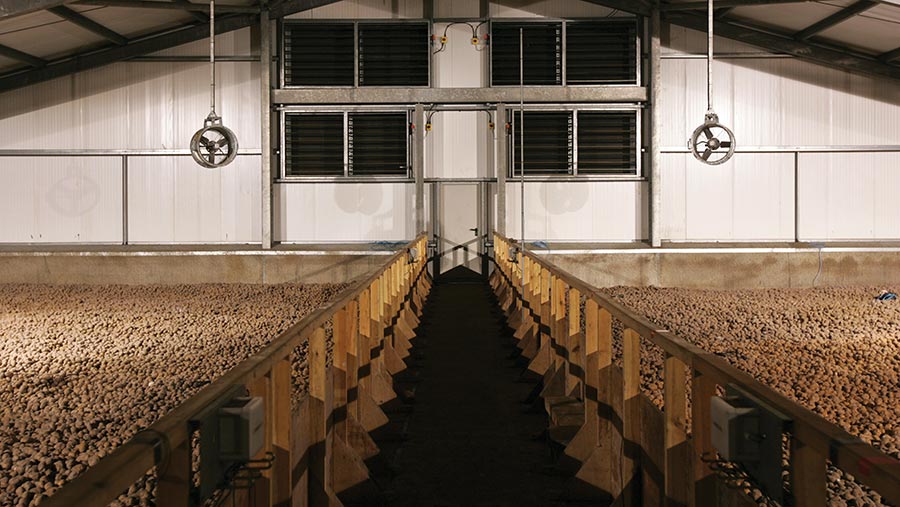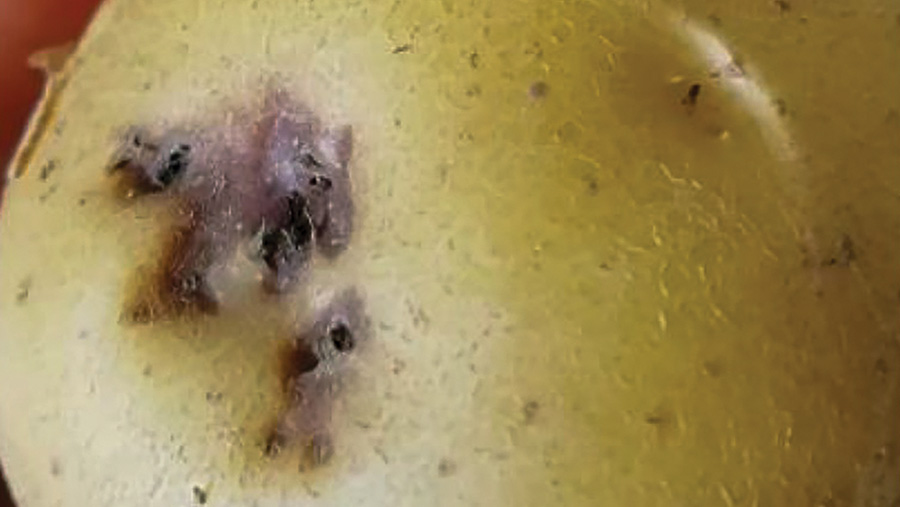Should you use DMN in potato stores this season?
 © Tim Scrivener
© Tim Scrivener Processing potato growers had a positive experience with a new potato sprout suppressant last year, with the product achieving good sprout control in very challenging circumstances.
However, pre-pack growers are worried about its use after treatment in some cold stores and on some varieties was linked to costly tuber defects during its first season of use.
See also: Morrisons pilot to cover cost of growing potatoes and carrots
Approval
New plant protection product approvals are increasingly rare, so in August 2022 when 1,4Sight (1,4-dimethylnaptheline or DMN) was approved for use in potato stores, it was warmly welcomed by the potato industry.
Following its approval, 1,4-Sight was widely used during the 2022-23 storage period and, in most cases, users were very happy with results, particularly in bulk-stored processing varieties held at temperatures of 7-8C.
One such user is Simon Alexander of SA Consulting, who specialises in potato agronomy and manages seed and processing potato stores across East Anglia.
He used it in all stores, except where ethylene was requested by processors McCain and Albert Bartlett. Every letter of the label and technical guide was followed before and after application.
The label allows for up to 120ml of product to be applied per crop and Simon made no more than three applications of 20ml (60ml in total) to potatoes in his long-term stores.
“Last year was a tricky season and DMN performed as well, if not better, than I would’ve expected of CIPC in similar conditions.
“It is promising how long crops held on at the backend between the last DMN application and crop movement. In the stores where we are allowed to use it again this season, we certainly will,” he says.
Fresh problems
Lincolnshire-based Simon Faulkner of SDF Agriculture looks after a mix of processing and pre-pack stores and had an equally positive experience with DMN where it was used on crops destined for processing.
However, some pre-pack growers saw incidences of external and internal defects in some varieties held in their cold-box stores – typically kept at 3-4C – and fogged with DMN.
Melody and Mozart were the worst-affected varieties. Conversely, varieties such as King Edward and Maris Piper, grown for the same market, seemed to avoid any of the same issues.
Samples of affected potatoes from some stores were sent to Fera’s plant clinic near York to check for bacterial or fungal pathogens, but these came back negative in all cases.
While some managed to grade out affected tubers and pack the majority of crop for supermarkets, others had significant tonnage that dropped straight into the stockfeed pile, resulting in significant final losses.
Farmers Weekly understands that a preliminary notice of legal proceedings against fogging contractors has been served, so discussing case specifics is not advised.
It should also be stated that so far, there is no concrete link between the defects and DMN use.
However, until there is conclusive evidence either way, Simon says it will be extremely difficult for any potato storage adviser to recommend the product in cold stores, despite manufacturer advice remaining unchanged.
“I won’t be using it on the fresh side. On the processing side, I don’t think anyone has any concerns and it worked very well,” he says.
Tom Green of Lincolnshire-based fogging specialist Stored Crop Conservation has taken a similar stance on applications.
“We would like to use it in all stores, not just processing, as it’s a great product to apply, was very effective last year at controlling sprouting and our customers have reported less weight loss with DMN compared with alternatives,” he says.
Condensation risk
So, what might have gone wrong? Scorch of tubers is always a risk when hot-fogging stores and condensation occurs at or soon after application.
There is plenty of independent and manufacturer advice on how to reduce this risk – measures include minimising crop, fridge (if present) and store fabric temperature differentials ahead of application.
However, with the most severe defects, the cause and any mitigating guidance is less clear.
Simon believes that last year’s advice to apply “as soon as the crop is dry” might be a factor, as tubers might not have been cured enough at application.
Curing is the process of healing any minor nicks or bruises and the thickening of skins. Speed of curing is largely influenced by tuber temperature (warmer means faster) and physiological age.
Last year, crops were heat and moisture stressed at stages throughout the growing period and sprouting in some varieties was evident in the field.
Furthermore, conditions were less than ideal for the application of maleic hydrazide – which for many forms the first line of defence against sprouting in store – so some farms didn’t apply or feared uptake had been compromised.
This triggered a knee-jerk reaction to treat in store early, but this isn’t always necessary, particularly in fresh stores where potatoes are cooled and then held at 3-4C, which limits dormancy break anyway.
“It isn’t unusual to see sprouting in the field in some varieties and, generally, if you get them into store, dry, cure and cool them, that initial sprout drops off anyway. The condition of the crop won’t get any worse.
“For me, the minimum period from loading to DMN treatment would be six to seven weeks. If you’ve used Fazor or Crown MH [both maleic hydrazide], there shouldn’t be any rush anyway. Let the MH do its job.”

© Tim Scrivener
Ongoing investigation
Ajay Jina of manufacturer DormFresh, who provides technical support to DMN users across the UK and Europe, says the company is working with businesses to establish if there is a link between the defects and DMN.
He says if any adverse interaction is confirmed, it will be in the company’s best interests to advise on how to use the product safely and effectively and avoid any further issues.
However, Ajay adds that the product has been used in cold stores in other countries since 2015 and there have been no problems categorically linked to DMN use.
Until then, he says the advice remains the same as it was last year, which is clear on the label and in the product’s technical manual.
This means sticking to the mantra “dry, cured and no condensation”. If this is followed, Ajay says there should not be any risk using the product in any crop, fresh or processing.
“We continue to work closely with contractors to advise on the best application techniques and improve understanding of when and where to apply the product. We also have an additional member of staff in the technical team to help give advice and visit stores.
“The UK industry has had one full season with DMN and will build experience and confidence in the product as we move forward,” he adds.
Treatment advice
Tom says where growers are able to use DMN this year, correct store setup is essential. The store should have its refrigeration unit turned off 24 hours before fogging and fans left running to even out store temperature.
As with mint and orange oil, the introduction of the hot fog should be as far away from the point of entry to the store as possible, giving the vapour time to mix evenly with the air before reaching the crop.
Introduction of the vapour should be measured – just 0.5 litres/min – due to the very low dose rate. Fans should also be run slowly on an inverter/speed controller during application.
Stores need to be sealed for 24-48 hours after application to ensure good uptake into tubers.
“The better sealed the store is at setup, the better the efficacy from each application, so ensure you check for leaks before any treatment,” he concludes.
French view – trials hint at DMN treatment risks and how to avoid them
French crop research institute Arvalis conducted controlled trials with DMN last year and results shed some light on the risk factors associated with any potential post-treatment tuber damage.
The product was first registered in France in 2017, but with little demand and no distribution partners, there were only a handful of commercial experiments until CIPC was withdrawn from the market in 2020.
Arvalis researcher Michel Martin tells Farmers Weekly that once the product was used widely, reports of defects in cold box stores after treatment with DMN started coming to light.
Like in the UK, evidence suggests there was some external necrosis around the rose end and eyes of tubers, with some internal damage spreading out from those lesions internally into the flesh. Ambient bulk stores holding processing varieties were unaffected.
Michel says there was an investigation by the manufacturer and industry to find common factors.
These are reported to be cold stores, thin-skinned varieties and introducing the DMN fog too quickly and too close to the crop.
DormFresh did update its advice based on the findings as a result, particularly around the introduction of DMN into stores.

© Arvalis
Storage trials
The reported issues inspired Michel and his team at Arvalis to set up some trials during the 2022-23 storage period to look at the causes and effects of damage in more detail.
Stocks of four varieties – Galante, Agata, Charlotte and Jazzy – were treated with DMN at a rate of 15ml/t. The variables investigated included:
- Mature versus immature tubers
- Optimal irrigation versus overirrigation during production
- Holding temperature of 4C versus 7C
- Condensation versus no condensation on the surface of the tubers at 4C
The treatments showed some differences, with variety and tuber maturity being clear factors.
No defects were recorded in any of the four varieties when tubers were mature.
However, where they were immature – meaning skins had not fully thickened – crop effects were seen in thin-skinned varieties Agata and Charlotte.
When considering temperature, little or no crop effects were recorded at 7C, with almost all confined to tubers held at 4C.
Although less clear-cut, overirrigation and condensation events did seem to add to a culmination of risk factors that could result in damage to tubers when fogging with DMN.
Michel stresses that after just one year’s trials, no concrete conclusions can be drawn from the work and the study will continue into the 2023-24 storage period.
Modified advice
However, Arvalis has modified its advice on DMN use for this year, urging farmers not to treat too quickly after loading stores.
This will ensure tubers are dry and have an adequate curing period before the introduction of product.
Spending sufficient time internally recirculating air before hot-fogging is also crucial to ensure an even temperature through the building and crop.
He recommends switching internal recirculation on again a few hours after treatment to maintain this even temperature, before any external ventilation begins 48 hours after the treatment.
Michel acknowledges that DMN is a dormancy enhancer, so its optimum timing is before any dormancy break in the store.
This means delaying treatment enough to ensure adequate drying and curing, but before any buds appear.
Michel concludes that loading stores quickly, evenly and with varieties with a similar dormancy profile helps.
Like other advisers, he believes an effective treatment of maleic hydrazide before haulm destruction is key, where possible, to provide early residual control.

